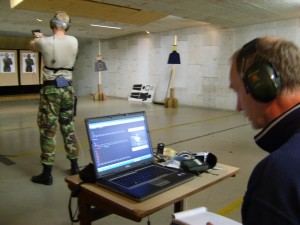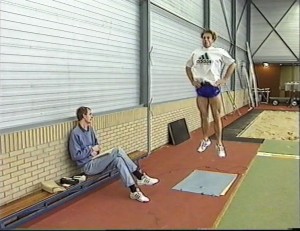For many decades scientists have been studying the heart and the muscle as being the dominant organs in human performance, but I never considered this to be the whole truth, I always thought the brain is where performance begins (or ends). I considered the muscles to be “the slaves of the brain” and I did a lot of testing with athletes on EEG and slow cortical potential.




In 1985 I published an article on the role of ammonia in fatigue, stressing the effect of ammonia on the brain. We also tested ammonia in training. (1)




Even in the last decades lots of time and effort was spend on studying the more peripheral factors in performance. Only in recent years one started to realize the importance of the brain in peformance e.g. fatigue. It was the work of, amongst others, Eric Newsholme and Niels Secher who focussed more on the brain as the main factor in fatigue in sports. Timothy Noakes who developed the concept of the “central governor model” and not forgetting Romain Meeusen who has done a lot of research on the effect of pharmacological agents on central fatigue a.k.a. CNS fatigue.
Yes, of course, even in the old days scientists have done work in that area, and again, a lot of work has been done in sport scientists in the former Soviet-Union. But it never really took off, got mainstream, found its place in textbooks, or found wide-spread practical implication in sports. Probably because at that time it was still difficult to study brain functioning directly.
Central fatigue is an expression that has been used by coaches for a long time, but always without properly defining what it is and not even having a clue about the physiological mechanisms behind it. Also there was no way to measure it or to design adequate intervention in order to e.g. recover from it. It was like: the athlete is tired, but not sore or fatigue in the muscle… so it must be central fatigue.
Now this blog is not really the place to go into detail about this, but I have been studying brain metabolism for a long time.
The brain is rather peculiar as far as energy metabolism is concerned:
- the brain monitors and controls all the energy metabolisms of the body.
- it uses a lot of energy: the body needs around 200 grams of glucose daily and the brain uses around 130 grams of it. The brain also consumes 20% of the body’s oxygen in rest, while it only weights 2% of the body’s weight.
- the energy turnover in the brain is rather constant.
- the brain predominantly uses glucose as a fuel, while the muscle can also easily use fats and proteins next to carbohydrates ( in special circumstances the brain can also use ketones and lactate)
- the brain has almost no storage capacity for its fuel.the brain works in close harmony with the stress systems to ensure its energy supply.
- the physical protection system called the blood-brain barrier is very specific in which substances can cross it.
The idea is, and that is not new, that the human brain takes very good care of itself, especially when energy metabolism is concerned.
A few basic ideas: after a war or famine, people lose a lot of weight, but in autopsies one will find that where muscle and other organs can lose up to 40% of its original weight, the brain losses less than 2% in its weight.
Now the brain is in a very good metabolic position since it arranges the energy metabolism of the other organs too, that’s handy, isn’t it? It controls the flow of glucose from the blood.
Basically this system governs and ensures the brains energy supply, the relevant physiological factors involved, like appetite and a wide range of hormones, it also controls of stress system like the autonomic nervous system and the stress hormonal axis (HPA-axis). And I have been lecturing on this interesting concept for some time now and if you understand these concepts well, it ties a lot of loose strings. But you have to understand some more than basic physiology, endocrinology and biochemistry.
The brain pulls glucose from the bloodstream e.g. by activating the stress systems who suppress insulin secretion, so more glucose stays available in the bloodstream instead of being stored into the muscle or the fat tissue. The body now pulls glucose from the food (appetite-signal) and when there is no food in the vicinity the body moves and starts looking for food. All these mechanism function to ensure a more or less continuous glucose level in the brain
The stress hormone levels predominantly make sure the brain gets enough glucose. Think about what happens when one suffers from hypoglycaemia, typical stress symptoms appear like trembling, sweating, heart racing, e tc. This happens because of the increased secretion of adrenalin to turn liver glycogen into glucose.
But when the system is not functioning adequately e.g. in aging, the brain might be lacking glucose, while the body might be forced to store the excess glucose in fat tissue.
You can imagine that optimal oxygen and glucose levels in the brain are necessary to ensure sports performances. Of course, training might be a good way to train these systems and stabilize oxygen and glucose levels, but in some athletes these systems don’t function optimally and they are more sensitive to small deviations, leading to unexplainable decrements in performance. Testing of blood glucose levels will be the first step, but it doesn’t tell the whole story yet, since that doesn’t tell how much glucose the brain receives. A complicating factor here is that one of the problems of hypoglycaemia is the fact that most people are unaware of it, they do not recognize the symptoms.
An example of the importance of maintaining optimal brain glucose levels: willpower.
Willpower or the capacity to exert self-control, is not the personal trait that we think it is. Research shows that willpower greatly depends on brain glucose levels! (2). Simple: exerting willpower requires glucose, after using ones willpower for a certain task, glucose levels will drop and less willpower can be exerted during less subsequent tasks! No glucose, no willpower. Wasn’t it Vince Lombardi who once said: “Fatigue makes cowards of all of us?”……. he was right.
Nutrition is a factor here but also the field of neuronutrition finally gains more importance. Neuronutrition means: optimal supply of substances that ensure optimal functioning of the neurons and the brain and protection from damaging circumstances, like free-radical formation, lack of oxygen, lack of glucose, or damage by neurotoxic substances.
- Kraaijenhof, H; Ammoniak – een vergeten vermoeidheidsfactor; Sportgericht Vol.7, No.6, november 1985, pg. 332- 335.
- Galliot, M.T; Baumeister, R.F; DeWall, C.N; Maner, J.K; Plant, E.A; Tice, D.M; Brewer, L.E; Schmeichel, B.J: Self-control relies on glucose as a limited energy source: willpower is more than a metaphor; J.Pers.Soc.Psychol. Vol.92, No.2, 2007, pg.325-336.
For further reading:
- Choi, I.Y; Gruetter, R (Eds): Neural Metabolism In Vivo; Springer Verlag, 2012.
- Parpura,V; Haydon, P.G (Eds.): Astrocytes in (Patho)Physiology of the Nervous System; Springer Verlag, 2012.
- Siegel, G.J (Ed.): Basic Neurochemistry. Molecular, cellular and medical aspects; Elsevier, 2006.
- Dwyer, D (Ed.) Glucose Metabolism in the Brain; Academic Press, 2002.
- Walz, W (Ed.) The neuronal environment. Brain homeostasis in health and disease; Humana Press, 2002.
- Cryer, P.E: Hypoglycemia, functional brain failure, and brain death; J. Clin. Invest. Vol.117, No.4, 2007, pg.868–870.
- Levin, B.E; Magna, C; Dunn-Meyell, A; Le Foll, C: Metabolic Sensing and the Brain: Who, What, Where, and How?; Endocrinology, Vol. 152, No.7, 2011, pg.2552–2557.
- Belanger, M; Allaman, I; Magistretti, P.J: Brain Energy Metabolism: Focus on Astrocyte-Neuron Metabolic Cooperation; Cell Metabolism, Vol.14, Dec. 7, 2011, pg. 724-738.
